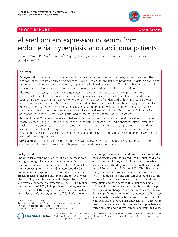摘要
Background: Endometrial carcinoma is one of the most common gynecological malignancies in women. The diagnosis of the disease at early or premalignant stages is crucial for the patient's prognosis. To date, diagnosis and follow-up of endometrial carcinoma and hyperplasia require invasive procedures. Therefore, there is considerable demand for the identification of biomarkers to allow non-invasive detection of these conditions.
Methods: In this study, we performed a quantitative proteomics analysis on serum samples from simple endometrial hyperplasia, complex endometrial hyperplasia, atypical endometrial hyperplasia, and endometrial carcinoma patients, as well as healthy women. Serum samples were first depleted of high-abundance proteins, labeled with isobaric tags (iTRAQ (TM)), and then analyzed via two-dimensional liquid chromatography and tandem mass spectrometry. Protein identification and quantitation information were acquired by comparing the mass spectrometry data against the International Protein Index Database using ProteinPilot software. Bioinformatics annotation of identified proteins was performed by searching against the PANTHER database.
Results: In total, 74 proteins were identified and quantified in serum samples from endometrial lesion patients and healthy women. Using a 1.6-fold change as the benchmark, 12 proteins showed significantly altered expression levels in at least one disease group compared with healthy women. Among them, 7 proteins were found, for the first time, to be differentially expressed in atypical endometrial hyperplasia. These proteins are orosomucoid 1, haptoglobin, SERPINC 1, alpha-1-antichymotrypsin, apolipoprotein A-IV, inter-alpha-trypsin inhibitor heavy chain H4, and histidine-rich glycoprotein.
Conclusions: The differentially expressed proteins we discovered in this study may serve as biomarkers in the diagnosis and follow-up of endometrial hyperplasia and endometrial carcinoma.
- 出版日期2011-4-14
- 单位复旦大学
